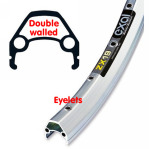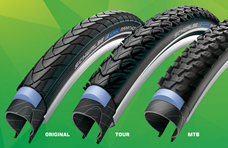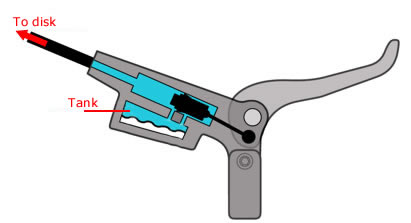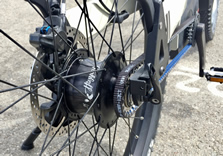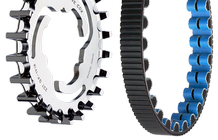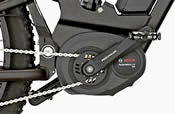


| < - > Bike — Sitting — Be heard — Push-back — Shield-oneself — Transport — Trailer — GPS — Drink — Camping — Energy |
| . . . Conventional Bike (Quality) — Electrical Assistance Bike (Quality) — Gearbox ROHLOFF |
WHAT TYPE OF BIKE IN CYCLO-HIKING?
Since we're talking about driving… so what's it going to be?
Between the cheap offers of the supermarkets and the misguided advice of most French cyclists, it is very difficult to make a choice without making many mistakes.
Let's look at the main criteria of choice, which are as many pitfalls.
THE BUDGET
THE CHEAP

We French have a habit that surprises many foreign cyclists. As for us cycling is rather secondary, we tend to go for the pas-cher. So the supermarkets, especially Decathlon, dominate the French market.
We even bought our first bikes in 2000… B'Twin from Decathlon. These B'Twin did us a favour, but we have to admit that their durability is low and therefore their low price is not profitable. It's a fake good solution.
No miracles with such cheap bikes, from 2005 to 2009:
- Martin, in cycling + Biketaf use, has "USED" THREE B'Twin.
- Betelgeuse, in cycle-hiking use only, has "USED" TWO B'Twin.
No major breakage but the suspensions, transmissions (etc) were taking up space everywhere. So they are not expensive, but not very durable and therefore not very profitable. Moreover this is NOT "sustainable development" at all!!!
FINANCIAL REVIEW: the base price of the Martin B'Twin is multiplied by 4.5 for use from 2005 to 2009. Multiplied by 1.5 for adaptation to cycling use, and by 3 for successive replacements due to premature wear, 1.5x3=4.5.
This illustrates our bad buying habits, at home in France. Let's compare budgets:
- The cost of the average basket of a French VTC buyer is 330 € (Decathlon bike or similar)
- The cost of the average basket of a German bicycle buyer is 1,500 € (German brands… qualitative!!)
- For 1,350 € (300 € x 1.5 x 3) Martin has only had 3 customised B'Twin bikes for 4 years (values for the years 2003-2010)
- While for the same price he would have had a resistant German bike, which he could have kept at least double the time.
Bicycle, car, household appliances… etc. the French low end of the range COST over time. Germans have the wisdom to reason according to the famous tirade "I can't afford to buy cheap".
THE QUALITY

Scalded by our cheap experiences we started research in 2010-2011 to orient ourselves towards quality.
Then in 2012, moving on to a period of life (retirement) where we would at least double our cycling time, we decided to take action.
We wanted to find a bike that was fully designed from the ground up for cycling. This is not easy, as the market is full of road cycling solutions (competition mode cyclo-sports).
Our first step was to test a transmission that was finally reliable and unadjustable. Living in Picardie at the time, we went to Paris to try a bike equipped with a ROHLOFF. We were amazed and conquered immediately. But we fell into a real ambush. The bike we were lent for this test was a RIESE & MÜLLER INTERCONTINENTAL-Extreme. Once on the bike… it was impossible to resist its appeal. Comfort, precision, rigidity, power and progressive braking. It was all great.
What wasn't so great was the price. It's German top-of-the-line. "Deutsch-Qualität" as they say.
After much thought, we ordered our two RIESE & MÜLLER. We have now ordered two consecutive 2012 cycle trips in succession. A small warm-up with a tour of Burgundy, then the cyclo-rando Budapest-Vienna-Prague-Hamburg-Cuxhaven. This showed us that our choice was inspired and perfect. Not a single problem in 3,000 km, no disruption, just fun. And this has been confirmed over the years and thousands of kilometres swallowed up in successive hikes. No problem at all. Peace of mind and maintenance budget almost nil: annual ROHLOFF oil change of a few dozen euros, that's EVERYTHING!
The investment in quality is consequent, but the return on investment is HYPER-INTERESTING. Quality is worth it and is worth the cost. QUALITY IS PROFITABLE.
Even without taking top-of-the-range as we have done, it is very clear by exchanging everywhere for years that the minimum budget for Quality is 1,500 €; of course ROHLOFF in addition since its price alone is 1,200-1,300 €.
Other reputable brands are chosen by a large number of cyclo-travellers. We can mention: TOUT-TERRAIN, CANNONDALE, KALKHOFF, MOUSTACHE, VSF FAHRRADMANUFAKTUR…
TECHNOLOGIES

In the criteria that will follow some will make many cyclists addicted to the super-light scream.
What, how? they will say, with all these choices the bike will perhaps reach 16, 18 or even 20 kg! What a horror!
Certainly, it's not the lightest! But no, it's not a horror. But what is for sure is for example to be broken from fatigue by breaking your back in the ruts (without suspension), or to struggle with broken spokes in the middle of nowhere (narrow wheels with single rims with fine spokes) or to have several punctures per trip (without the heavier but almost puncture-proof SCHWALBE tires).
Heavier, we'll drive a few miles per hour slower than you? Ah! What a bargain. Okay, now get out in front of us, you great lightweight sportsmen. Bravo, you will win by arriving every day 15 or 30 minutes before us at the stage. But we will arrive every day less tired than you. And we'll arrive before you every time your obsession with lightness has put you in trouble… Each one has his own choices, some are tired and struggling, others are constantly having fun!
In fact, the central problem is that most French cyclotourists come from the racing bike (road bike). However, this environment is conservative, recalcitrant to changes. An example: disc brakes appeared at the end of the 90s. The mountain bike community took them up immediately. The road racing community has not stopped criticizing it, lynching it. At the time of writing, in 2020, it has only been 3-4 years since this conservative community finally admitted, recognized the qualities of this technology. They are finally starting to embrace it. Sales of road racing bikes are growing at a rapid pace with this state-of-the-art braking system. It will probably take another 20 years for these conservative touring cyclists to finally admit that fully suspended frames are a must for touring bikes.
FRAME AND SUSPENSION

Most French cyclists have their minds distorted by their main activity and historical clientele: road cycling and road bike touring.
They all reason on the basis of hyper-light, hyper-fast cycling tourism. So their ADVICE is BAD, or unsuitable, because it is exclusively oriented towards lightness and performance to the detriment of comfort and pleasure. They recommend thin wheels and tyres (at most VTC type) and no suspension.
These specialized bikes are very well adapted to asphalt. However, as soon as you ride on roads, and if the roads are also rough or stony, this is not the right choice at all. However, the most pleasant and attractive cycle routes are bound to have roads that are not passable.
In fact we are not talking about the same thing. Road cyclists only ride on billiard smooth asphalt… and always ride very close to cars. We, nature touring cyclists, avoid cars as much as possible. We also accept to ride on stones, crevices, potholes… So the reasoning and choices are necessarily different.
Super-light cyclists make a face when we talk to them about suspension bikes. Saying that such a suspension makes you lose pedalling energy. In reality, the loss of energy is tiny (a few unfortunate percent). On the other hand, the gain in comfort and resistance to fatigue is enormous, especially on rides lasting several weeks.
The extra weight and the loss of energy are endlessly rehashed without any critical thinking. The elders can't stand the slightest change and everyone resumes their commonplaces as widespread as they are inaccurate. But as this influential group claims, everyone believes in them and repeats these untruths.
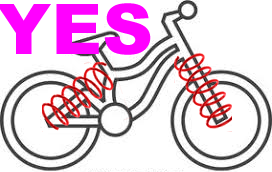
Therefore, regardless of other financial or technological choices YES we highly recommend the choice of an ALL-SUSPENDED bike, front fork AND frame.
This "ALL-SUSPENDED" technology is moreover totally recommended for your health. See here for ailments related to cycling.
In cyclorriding we are not in the constraints of the downhill mountain bike, so 100 mm suspension travel is more than enough. But air shock absorbers are a very good choice to allow an easy variation of the settings according to riding empty or loaded.
The old endless debates between ALU or STEEL frames are now outdated. They are very comparable in weight and strength. The only downside is the low end of the aluminium range (hello Decathlon) where resistance is not at all guaranteed. For quality bikes, the reparability argument (welding) of steel is no longer relevant. Both aluminium and steel are very strong, especially in the suspended version. However, for travellers from the other side of the world who take their bikes in the hold of the plane, steel is probably preferable, because bikes are VERY mistreated by airport baggage handlers.
WHEEL - RIM

Another open-ended debate concerns wheel sizes. It is an endless litany of arguments for and against the different sizes: 26", 700, 27" and now 27.5" or even 28". Fashions change, debates remain… for not much.
The 26" pros will say that it's hyper standard all over the world and that you can help yourself everywhere. In reality, the rim resistances are now very good, especially in double wall rims (very recommended). So it's not a significant argument anymore.
Others praise the bigger sizes for the comfort. When one has chosen, with good reason, an all-suspended bike, comfort is totally acquired by the suspension, the difference obtained by the wheel diameter is then insignificant…
Therefore the wheel diameter is no longer a relevant selection criterion. On the other hand it is necessary to pay attention to 4 essential points:
- Double-walled rims (as shown above) for the best resistance.
It is common not to see a pothole drowned in a thunderstorm rain; in the shock, on the protruding edges of the pothole, a single-wall rim has a good chance of making its last turn. - For solid wheels prefer a number of spokes of 32 or 36.
- Spokes of 2mm min.
- Spoke holes in the rim reinforced with eyelets to avoid the risk of cracking.
These 4 points are important for the resistance in cycle tourism, because bikes are very loaded and therefore the shocks on the defects of roads and paths are violent. Ordinary rim and spoke wheels will offer a maximum chance to have a big breakage that will stop the ride!
WHEEL - TIRES
In terms of tyres, the indispensable reference for touring cyclists is the SCHWALBE brand with its MARATHON-PLUS range of tyres, which is rightly reputed to be INCREVABLE. This is thanks to its thick BLUE BANDE FAME integrated into the tread (see SCHWALBE). Yes, it's a little heavier (I see a few that make a face)! But, wow, it's wonderful this little extra weight that prevents you from having a flat tire and therefore, for example, from having a hard time unloading your gear in the mud and trying to correctly stick a patch on an inner tube soaked by the rain !!!
In terms of tyres, the indispensable reference for touring cyclists is the SCHWALBE brand with its MARATHON-PLUS range of tyres, which is rightly reputed to be INCREVABLE. This is thanks to its thick tread compound (see ). Yes, it's a little heavier (I see some that make a face)! But, wow, it's wonderful this little extra weight that prevents you from having a flat tire and therefore for example to have a hard time unloading your gear in the mud and trying to properly stick a patch on an inner tube soaked by the rain !!!
This MARATHON-PLUS range also offers super-efficient treads. From the Marathon-Plus-ORIGINAL to the Marathon-Plus-MTB to the highly renowned Marathon-Plus-TOUR. These 3 types of tyres range from the smoothest (ORIGINAL for 99% asphalt) to the most studded (MTB for many roads, including muddy ones). With for TOUR and MTB a central section rolling well on asphalt (good performance and silence) and side sections with good grip.
When going on roads, which can be sandy, muddy or stony, narrow tyres are unsuitable, as they sink into these different terrains, causing the physical effort to skyrocket. The best is a width of 2" to 2.5". With these dimensions the ground pressure becomes lower and you can overcome these difficulties much better and with less effort.
Some aficionados of lightness (for more speed and kilometers) refuse the all-suspended and try to compensate for the hardness endured by very wide and under-inflated tires. We advise against this. Indeed, in wet weather puddles can hide dreadful potholes, and it is then that surprised by such a hidden danger, there is every chance that this under-inflation does not protect the rim. And that's how some people find themselves with a rim at best deformed, at worst burst.
BRAKE
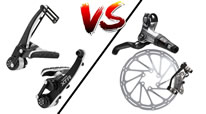
Another subject, and one more debate to go on and on the brakes. So rim brakes (V-Brake) or disc brakes?
With rim brakes (V-Brake or others), when you go through a mud pocket, all the following braking is strongly reduced by the mud which makes lubricant and prevents a braking worthy of the name. Moreover, this mud, pressed under the brake pads, causes accelerated abrasion of the rims (worse with sandy mud). With disc brakes, there's NO more to worry about.
Even for those who don't drive on muddy roads, the advantage of disc brakes is that they naturally evacuate all water and humidity. This guarantees constant and efficient braking performance in all weather conditions.
During long and heavy braking, rim brakes cause the rim to heat up, resulting in a loss of braking efficiency. With disc brakes the performance is constant.
We must not forget that as cyclotourists we are heavily loaded (especially in cyclo-camping). And that we have to be able to stop in case of unexpected danger. This maintenance of the braking at its nominal power in all circumstances is INDISPENSIVE. It is out of the question, on the grounds that we passed through a mud puddle in the middle of the road, not to be able to avoid a car that comes out of nowhere at full speed on a road, a few minutes later. Braking is vital, it has to be "NOMINAL POWER" "ALL THE TIME". Only disc brakes allow this safety.
We have tested bikes with mechanically operated disc brakes. Well, we largely prefer hydraulically operated disc brakes for their outstanding progressiveness. From soft to hyper-powerful, in all comfort and safety. And with quality brands (Shimano, Magura) no maintenance complications as criticized in the past. From time to time (not even every year) a simple purge. Frequent oil changes are only necessary on mountain bikes that ride down steep slopes with sick brakes all the time… because in this case the pads AND oil are heated to high temperatures. This degrades the properties of the oil and results in the need for frequent oil changes. This is not our case.
On this subject, don't forget that on very long descents (after a pass for example), even on our touring bikes, you should not apply the brakes (even gently) all the time. It is better to alternate sequences of strong braking and complete release of the brakes. This is true regardless of the brake technology.
Another advantage of hydraulic disc brakes is the automatic wear adjustment. With rim brakes, when the brake pads wear out, the brake levers must be pressed down every time the brakes are applied to make up for the slack. This means that before the braking effect is felt, the brake pads must first travel the distance between their rest position and their position of contact with the rim. This play is several millimetres, since it's not every night that you have to play with the adjustment wheel to correct this play. This distance to be caught up before the skid-rim contact is waiting time before the actual start of braking. It is therefore additional distance travelled towards the danger that we want to avoid.
With hydraulic disc brakes (not mechanical cable brakes) the pads are ALWAYS in almost contact with the disc (to the nearest tenth of a millimetre), thanks to the mini oil reservoirs included in the brake handles. These tanks allow to re-inject, in the pistons that push the pads, the extra oil that brings the pads closer to the disc as they wear. Thus the braking action with HYDRAULIC disc brakes is ALWAYS almost INSTANT. This can mean the difference between a danger avoided and an accident! Mechanically actuated disc brakes have the same delay disadvantage as rim brakes, since the wear of their pads must also be corrected manually by re-tensioning the cable.
To top it all off, the power of the hydraulic disc brakes offers an extremely significant reduction in braking distances, of the order of 40%. This is a considerable advantage.
Finally, it should be noted that hydraulic disc brakes require less muscular effort for the same braking power. Therefore all people, who do not have an extraordinary grip, will appreciate having less muscular tension in their hands at the end of the day.
TRANSMISSION
The transmission is everything that concerns the transfer of muscular effort to the wheel: crankset, chainring, chain, sprocket set.
It must be able to ensure a development (distance covered per turn of the crankset) small enough to climb hills and large enough to descend downhill. A transmission is therefore characterized by its percentage of amplitude of development.
GEAR CHANGE VIA DERAILLEUR
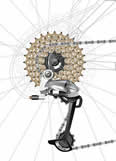

The traditional 27-speed double derailleur transmission with 3 chainrings on the bottom bracket and 9 sprockets on the rear wheel (3x9=27v) provides a development classically ranging from 1.45 m to 7.45 m per crankset revolution. This corresponds to a total development range of 528%.
It should be noted that when changing gears the chain changes position laterally. As it is necessary to avoid crossing the chain (twisting it between large chainring and large sprocket or between small chainring and small sprocket), this means that in practice a 27-speed transmission has only 14 usable speeds.
This transmission equips ALL bikes from the bottom of the range up to good quality bikes (bike budget 330 to 1 500 €) with of course derailleurs of variable quality depending on the price of the bike.
So in this price range, no question to ask is multi-plateau - multi-pinion transmission.
On such a traditional transmission you can't change gear when you stop, you have to ride to change gear.
So the trap is to find oneself facing a very steep slope when changing direction; or to have to stop in a hurry when one was on a big development. With a classic derailleur gearbox the problem is to start again by moving the gears back down (sprockets… AND chainring!). With a city bike you press very lightly while changing gears, or at worst you get off the bike, lift the rear wheel and change gears.
But on a touring bike, well loaded with bags and panniers, it is impossible to do this. Blocked in over-development facing a slope the only solution is to turn the bike around to get back down the gears. And if you're on flat ground you get off the bike and push the bike while shifting the gears (sprockets and chainring) gently one after the other. In short, it's a mess.
The other problem is on slopes with fluctuating gradients. Here you have to change gears regularly, up or down, but in any case constantly and alternately. With derailleur gears, the problem is when you have to change the chainring as well. Because when changing the chainring, you also have to juggle with changing the sprocket to get the right development. Loaded with 25kg of luggage… it's sporty… not to say, often, a pain in the ass. Because by the time the chain has deigned to change the chainring and the sprocket, the speed of the bike has dropped (since you don't have to press hard on the pedals)…! In short, another mess and, moreover, a very frequent one.
Finally, even with a well-adjusted top-of-the-range derailleur, there is always a moment when the chain derails. Like, for example, during a sharp bump in the road just as you're changing gear… There, the undulations of the chain can cause it to derail. And who hasn't been in trouble with the chain getting stuck at the foot of the small chainring, or between the large sprocket and the spokes? Grrrr!
GEAR CHANGE IN HUB

As we have seen in the previous chapter, gear shifting with derailleur gears has serious disadvantages for touring cyclists. With these derailleurs you juggle with two shifters and three coupling ranges:
- Range 1: chainring 1, sprockets 1 to 5 (small developments)
- Range 2: chainring 2, sprockets 4 to 8 (medium developments)
- Range 3: chainring 3, sprockets 6 to 9 (large developments)
With these derailleur gears the stepping (the jump between the different successive couplings) is not regular. It usually varies between 7 and 17%. This means that between each gear change there is not a good progressiveness of development. Between the 14 useful speeds (of a 27 speed system (3x9)) the step (in %) is as follows: 13.3, 15.4, 13, 15, 15.9, 15, 11.1, 12.5, 14.3, 6.9, 12.5, 14.3, 16.7%. In other words, the muscular feeling is very variable.
Derailleur technology has a very wide development range, which is a very big advantage. For a 3-sprocket - 9 sprockets system, i.e. 27 speeds, the development range is usually 528%.
Another technology exists, which is shifting in the hub. Here, double advantage, there is only one action on one organ and you can CHANGE Gears at STOP.
On the other hand, almost all brands of hubs (all EXCEPT ONE) have a limited number of gears and, as a corollary, a limited total range of development:
- SRAM from 3 to 7 speeds (from 186 to 303 %)
- STURMEY from 3 to 8 speeds (from 117 to 305 %)
- SHIMANO from 3 to 8 speeds (from 186 to 307 %), and Di2 11 speeds (409 %)
- NU-VINCI continuous variation (350 %)
- ROHLOFF 14 speeds (526 %)
It is immediately obvious that three hubs are unusable for bicycle touring, they are only suitable for city bikes or Sunday rides. The 11-speed SHIMANO Di2 is suitable for those who ride light with not too pronounced relief. ONLY the ROHLOFF hub allows you to ride in comfort (not light) and on all types of terrain.
Facing the derailleurs the ROHLOFF:
- Allows you to tackle ALL terrains, as it has the same development range as the derailleur system (526% vs. 528%).
- Has the same number of useful speeds (14 for 14).
- Provides an almost constant tiering of 13.5 to 13.7% (compared to 6.9 to 16.7% for derailleurs). It is much more pleasant, the effort is more regular.
With the ROHLOFF there is no need to worry about shifting gears:
- We change gear when we stop.
- Simultaneously change the number of gears you want on the fly in less than half a second (great in slopes with fluctuating slopes (see above with derailleurs)).
- When it rains, the best protection is the cape that goes up to the handlebars. But this hides the control levers. With derailleur gears, you don't know which chainring you're on… so the risk of chain crossing, risk of derailment… it's not good at all.
With the ROHLOFF, you don't care where you are: it's too hard so you downshift, it's too easy so you go up a gear… no questions to ask, no risk of damaging anything… From speed 1 to speed 14 it's a continuous clic-clac, I increment or decrement according to the feeling, the need!
The detailed description of the ROHLOFF gearbox can be found at page ROHLOFF.
The ROHLOFF is a marvel of mechanics, it's a gearbox. So the price is not at all the same as a derailleur. Compared to a good derailleur you have to count 1,100 € more. But once you have used it, it's IMPOSSIBLE TO LEAVE IT OUT.
FROM CRANKSET TO WHEEL: CHAIN OR BELT?
With a derailleur gear change there is no question, the transmission from the crankset to the wheel is by definition and necessarily a chain. It is the only device that accepts derailleur shifting, in other words, changing position laterally from one chainring to the next and from one sprocket to the next, and which also accepts misalignment (the sprockets are not aligned with the chainrings).
However, with a gear change in the hub, the transmitter (on the bottom bracket) and the receiver (on the wheel) are aligned. Under these conditions a belt can be used. Such a belt is notched (it has teeth) to avoid slipping on the drive pulley of the crankset and on the receiver pulley of the wheel. We talk about synchronous drive, there is no slip as it would be with a single belt (even V-belt).
At a slight extra cost, the belt has the following advantages:
- Virtually no maintenance. At the worst a small spray of water at the end of a really particularly and excessively muddy stage.
- Great durability and stability with the great specialist Gates Carbon Drive. It wears much less quickly than a chain.
- Smooth and silent operation.
It should be remembered here that with a trip on dirt, sand or muddy tracks a chain requires almost daily maintenance (cleaning, lubrication).
For those who would be afraid to opt for a too recent technology, it should be remembered that it is only recent in its application on bicycles. Otherwise it has been used in industry for at least 70 years and in the automotive industry since the 1970s. It is therefore an extremely reliable technology.
LIGHTING
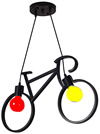
To put it bluntly, the only high-performance lights are LED lights.
For summer use only, battery solutions are available. However, if you want to use your bike all year round, the right solution is a dynamo in the front hub. The best dynamos are those of the brand SON (Schmidt Original Nabendynamo).
As for headlights, the best brands are Busch & Müller et Supernova
TYPE OF BIKE - CONVENTIONAL OR E.BIKE


In 2020 we can no longer escape the question: CONVENTIONAL BICYCLE or ELECTRICAL ASSISTANCE BICYCLE (E.Bike)?
TERMINOLOGY
In what follows, and by convention, the initials CB will be used for "Conventional (or Classical) Bicycle" and initials EAB for "Electrical Assistance Bicycle".
PREAMBLE
For more than 10 years, discussions have been going on to praise or decry EAB (especially in France). Most of these discussions are futile and sterile. Fortunately, in 2020 the sorting starts to be done.
We find in the forefront of the detractors the pure and hard historical detractors of the CB.
Since the beginnings of the EAB the biggest criticism has been that an EAB is not sport, there is no more effort, it's too easy.
This reproach is ALMOST false. Almost, because there are two cases where there is no more effort:
- Some electric bicycles in North America, sold under the name "THROTTLE DRIVE". These are not bicycles. They are more like MOTORBIKES with a throttle on the handle. No need to pedal, just turn the throttle handle watts. They are only allowed in North America and strictly forbidden elsewhere, especially in Europe.
- The first generation European EAB are very basic technology. With these old designs, as soon as the pedals are actuated, even with almost no pedalling effort, the power assist engages directly at its rated power. Pedal stationary… no assistance, crankset turning… full assistance. This is indeed VERY LOW effort, and it's very uncomfortable and unpleasant to ride. The engagement and disengagement are violent and the autonomy is low, because the power assistance is always applied at the maximum.
This first generation still exists in the EAB LOW-COST, in the lower range.
Otherwise for all the real EAB (above the low end) all this is false. In reality, although equipped with an engine, a real Electrically Assisted Bike does not eliminate the effort required by the cyclist at all. It is NOT an electric bicycle, it is not a moped! Real EAB respect the presence of the "A" for Assistance. There is ALWAYS some effort to produce. Indeed, the assistance only engages when you press the pedals. You stop pressing on the pedals (you just follow the movement of the crankset)… then the assistance also stops!
Technologically, the first generation of VAE only needs a simple rotation detector (detects if the crankset is spinning or not). On the latest generations THREE sensors measure :
- Pedalling frequency (cadence) (pedal rotation speed)
- Pedalling power (the torque on the crankset, resulting from the force applied to the pedals by the cyclist)
- The speed of the bike.
With the best electronics the measurements of these sensors are made more than 1,000 times per second. This guarantees a high degree of proportionality of the assistance. Equipped with such an electronic regulation, true EAB (above the low end of the range) imply a real physical commitment.
However, it is obvious that for the same route covered at the same speed, an EAB requires less effort than a CB.
But thanks to the assistance provided with an EAB, you can make faster, longer and/or steeper journeys.
In short, with the same effort as on a CB, an EAB allows you to go faster and/or further and/or with more relief.
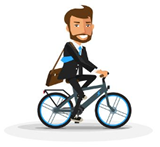
By the way, don't be fooled by the special case of urban cyclists, in suits and suits, who pedal cool, with their backs upright, spinning at full speed without producing a drop of sweat, even in the middle of a heat wave! These people, and there's nothing to reproach them for, ride their bikes and don't want to have to take a shower when they get to the office… while going as fast as possible to minimize their travel time. So, naturally, they put the assistance in super-turbo mode. They're absolutely right. And for the few kilometers they do, the range is not a problem at all.
For all the others, apart from these bikes, the effort is there and well there. Otherwise these others would not go very far, the battery would be drained very quickly.
As a result, many mountain bikers, who are always proud to show the physical demands of their activity, are now hyper-fans of EAB. They can perform even better with the same level of physical commitment.
Recently, even many road cyclists (who are also proud to demonstrate their physical performance) have started using EAB. With the same effort, they are able to stretch their Holy Grail even further: to cover even more kilometres in even less time. And it is also very advantageous for senior road cyclists who can rejoin the Sunday bunch. Riders that they had left forced and coerced because of their reduced performance due to their advancing age.
The success of EAB in these 2 previously totally resistant worlds is easily demonstrated by the explosion of models offered to these audiences and the sales made to them in recent years.
In short, for all categories of practices and ages, EAB offers even more sensations and pleasure than CB.

Another reason to opt for an EAV is the loss of physical performance due to illness and/or medical treatment.
We have had this difficult experience ourselves.
After undergoing heavy medical treatment during the year 2018, the physical performance of my Betelgeuse-Darling was diminished. And this was predicted to last 2 to 3 years.
Before this thunderclap we were only considering acquiring EAB after celebrating a few birthdays as septuagenarians. But, not starting again in 2019 was morally unbearable, especially for my Chérie.
We solved the problem by buying EAB at the beginning of 2019… And that's how, finally, we were able to resume our wonderful cycling trips in the summer of 2019. My Darling was thrilled to be able to make two 2,000 km long rides that summer. It would have been impossible without EAB.
SO CONVENTIONAL BIKE OU ELECTRICAL ASSISTANCE BIKE ?
From all the above it is clear that the EAV lends itself to ALL usage profiles.
In any case, the real EAB adapts to what everyone wants. In short, it is up to you to choose between the Conventional Bicycle and the EAB:
- Perform MORE than a Conventional Bike but with the SAME effort.
- Make LESS effort while getting AS much performance as with a Conventional Bike.
IT'S A WIN-WIN SITUATION FOR EVERYONE.
So CB or EAB is entirely a choice of taste or circumstances… depending on each one.
On the other hand for the choice of a EAB the activity bicycle tourism is, as for all the other technological subjects, a speciality which requires to make particular and adapted technical choices.
ELEMENTS OF CHOICE FOR A CYCLE TOURISM EAB



Technologically there are 3 possible arrangements for the motorization of EABs:
- In the front wheel. The cheapest, not very efficient, uncomfortable (heaviness in the handlebar rotation) and reserved for flat terrain without hills. Complications in the event of a puncture.
- In the rear wheel. Attractive price, interesting for the city, lack of torque on hills and weakness in the need to restart after slowing down or stopping. Even more complications in the event of a flat tire.
- Central, in the bottom bracket. The most expensive, but it's the only one with enough torque to tackle hills and regain speed. It's also the only one that offers the most natural pedaling. And no worries in case of a puncture.
Given the weight of luggage we all carry on a bicycle touring, a bicycle touring EAB must have a high torque and a large battery… the weight consumes Watts (as soon as you climb).
So the right choice for cycle touring is :
- Pedal motor. Because it's the only one that can provide enough torque to move our heavily loaded frame. It is also the most proven in terms of reliability.
- Batteries on or in the frame, in any case above and slightly in front of the motor. Because this is the arrangement that allows the best balance of the masses. Batteries on luggage racks shift the centre of gravity too high and too far back due to the presence of the rear panniers.
As explained in the previous chapter, it is imperative to ensure that the EAV regulation integrates the famous 3 sensors (cadence, torque, speed) described in the previous chapter.
The most famous brands of bottom bracket motors are BOSCH, YAMAHA and PANASONIC.
A user of EAB who only rides in his region or who spends his holidays in a sedentary way by walking in a star shape around his holiday resort will be able to choose any of these serious brands. His retailer will be able to provide for his maintenance and breakdown service as it should be.
On the other hand, our travels take us to various countries and there is no guarantee that we will find all the brands among the retailer in case of need for even the smallest repairs.
It is good to know that BOSCH is the oldest and most widespread manufacturer. They have (VERY FAR) the largest fleet of EABs in service and also the largest number of cyclists who sell them. A BOSCH specialist can be found almost everywhere along the way. So our advice, and our choice is to privilege this brand.
The PERFORMANCE LINE CX is the BOSCH engine whose torque is the most suitable for cycle touring.
Their control system offers 4 levels of assistance: ECO, TOUR, EMTB and TURBO.
If you don't drive more than 50 km per day, a 500 W battery will probably be enough, unless you're constantly riding TURBO or climbing vertiginous passes.

Beyond that a DUAL-BATTERY will probably be necessary. The 2 batteries will be installed for example one in the frame and the other on the frame.
In any case it is strongly advised to determine the necessary battery capacity with the help of their eBIKE RANGE ASSISTANT. This assistant is very close to reality, it is very reliable. Provided, of course, that ALL the parameters are set realistically.
For those who hike or walk in winter it is imperative to take into account the strong degradation of ALL current batteries with winter temperatures. It is often quoted the figure of 30% drop. This can also be a reason to equip yourself with DUAL-BATTERY.
WHERE TO BUY HIS EAB?
Important question: where to buy your EAB.
Many will naturally answer: from a (my) bike shop.
For us, the right solution is to contact an EAB SPECIALIST, because :
- Generalist bike shop have little choice of brands AND models, and this is normal, as they cannot continue to have a large Classic range AND add a showroom and a full stock of EAB. This is financially too heavy and practically impossible in terms of available space.
- EABs have technologies that classic cyclists have absolutely no mastery of.
- The after-sales service of EABs requires adapted personnel.
At home in Nantes, there are a lot of cyclists. We have a large number of quality cyclists. But there is almost only one rider who really specialises in EAB, and that is BIKE-CENTER. They only sell EAB. And you can tell the difference. They're the only ones to have so many brands and models with so many choices of use, performance, technology and price… And all with demo bikes and stock.
SITTING - THE SADDLE
A specific page is dedicated to this essential piece… Sitting - Saddle.
OUR TOURING BIKES
FIRST BIKES - CHEAP
As explained elsewhere, our first bikes were Decathlon bikes. Let's go quickly through this episode!
SECOND BIKES - QUALITY - CONVENTIONAL BIKES
In 2012 we switched to Conventional Bikes (Quality)
THIRD BIKES - QUALITY - EAB
Transition to Quality Electrical-Assistance-Bicycle en 2019.
